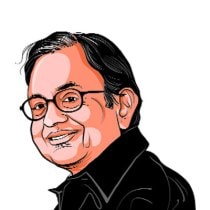Across the aisle: Governments hide, people seek
The mood of the nation is despondent. In the RBI’s survey (May 2018), 48 per cent of respondents felt that the economic situation had worsened in the last one year. In some sectors, like agriculture, despondency has turned into anger. Among some sections of the people, like Dalits and unemployed youth, despondency has turned into despair.
It is not clear who is in charge or what policy changes will be made. The Cabinet is a mute spectator. The PM’s Economic Advisory Council has disappeared without a trace. I wonder how long will the government hide behind a number and a slogan. (Photo: PTI)
How much can you hide behind one number? A lot, if the media played ball.
On the day after the Central Statistics Office (CSO) released the growth numbers for 2017-18, the media played up just one number: 7.7 per cent. At first blush it appeared to be the GDP growth number for the whole year 2017-18, and was certainly impressive. Actually, it was the growth number for just one quarter, Q4, and the uptick was also because of the low base effect. For the whole year, however, the GDP growth rate was a sobering 6.7 per cent.
The government puffed up the Q4 growth rate and claimed that the worst effects of demonetisation and a flawed GST were over. Mercifully, the government stopped short of making the claim that achhe din had arrived. At the end of four years, the government has switched over to a modest Saaf Niyat, Sahi Vikas (Clean intention, right progress)!
The path of the BJP-led NDA government’s four-year journey is littered with too many broken promises: Rs 15 lakh in every bank account, 2 crore jobs, MSP at cost + 50 per cent, waiver of agricultural loans, insurance cover to all farmers, peace and security in Jammu and Kashmir, a good and simple GST, and many more. You can add to the list from your own experience.
Look at Outcomes
At the end of four of the five years allowed to a government, the people cannot be expected to judge a government by its intent. The correct test is outcomes. Look at the boxes with the graphs. Every line depicts a measurable parameter. And every line, after showing promise in the first year, has dipped.
Some conclusions can be drawn without fear of contradiction. Beginning 2012-13, the economy was on the mend, and the GDP growth rate accelerated from 5.5 per cent in 2012-13 to 6.4 per cent in 2013-14 to 7.4 per cent in 2014-15 to 8.2 per cent in 2016-17. The story thereafter is one of steep decline. From 8.2 per cent to 6.7 per cent in two years, it is a fall of 1.5 per cent — exactly what I had predicted after demonetisation.
Miserable Story
Other lines in the two boxes also tell the miserable story:
Credit growth dipped drastically from 13.8 per cent to 5.4 per cent before recovering somewhat in 2017-18. Within credit growth, it is credit to industry that is important. In the last four years, annual credit growth rates to industry were 5.6, 2.7, -1.9 and 0.7 per cent.
The index of industrial production (IIP) has remained flat. That number demolishes the claims on behalf of the much-touted Make in India programme. Besides, as far as defence production is concerned, the Make in India model was officially abandoned a few days ago (see Business Standard, June 6, 2018).
Gross NPAs have risen from Rs 2,63,015 crore to Rs 10,30,000 crore and will rise more. The banking system is practically bankrupt. I have not come across a banker who will willingly sanction a loan; nor an investor who will confidently borrow money. The economy is running on just one wheel — government expenditure.
Gross Fixed Capital Formation (GFCF), after falling from 31.3 per cent in 2013-14 to 28.5 per cent in 2015-16, is stuck at the same level for three years, proving my point that private investment is in the doldrums.
Merchandise exports hit a peak of USD 315 billion in 2013-14. Since then, the figure has struggled to cross USD 300 billion and, in two out of the four years, it was well below the peak.
Mood of Despondency
We could pick up more economic indicators and draw the lines on a graph. It will be the same story of poor analysis and reckless decisions (demonetisation, flawed GST, stagnant farm wages, high fuel prices, intimidating tax recovery, mala fide investigations etc).
The mood of the nation is despondent. In the RBI’s survey (May 2018), 48 per cent of respondents felt that the economic situation had worsened in the last one year. In some sectors, like agriculture, despondency has turned into anger. Among some sections of the people, like Dalits and unemployed youth, despondency has turned into despair.
It is not clear who is in charge or what policy changes will be made. The Cabinet is a mute spectator. The PM’s Economic Advisory Council has disappeared without a trace. I wonder how long will the government hide behind a number and a slogan.
For all the latest Opinion News, download Indian Express App
More From P Chidambaram
- Across the Aisle: Second-class citizens?Under the government of Mr Narendra Modi and his cohorts in the states, unlike the government of Mr Vajpayee, intolerance is the new normal...
- Across The Aisle: Who is minding the store?Public anger is building against high prices of petrol and diesel. Between 2014 and 2018, due to low prices of crude oil, government saved Rs…
- Across the Aisle: Who will save the Constitution?The question that remains is, will the legislators elected on their respective party symbols remain faithful to the party, to the voters who supported them,…






































No hay comentarios:
Publicar un comentario